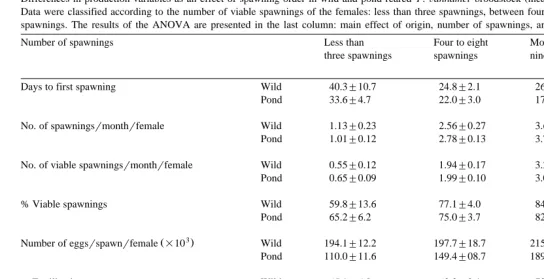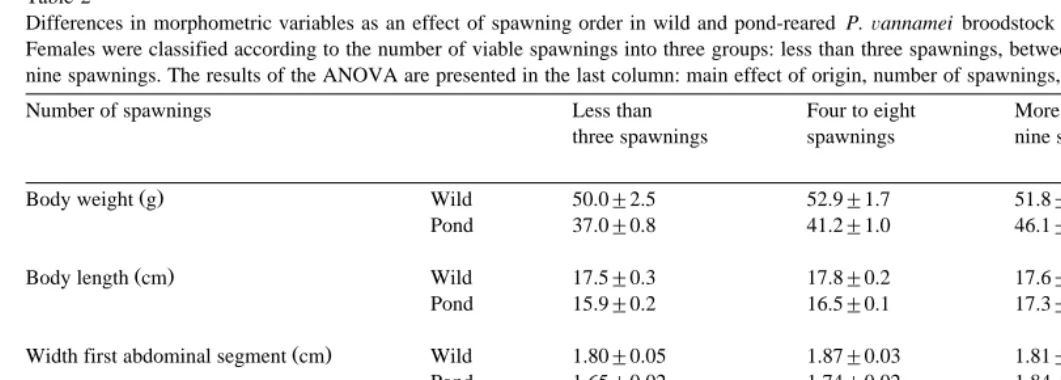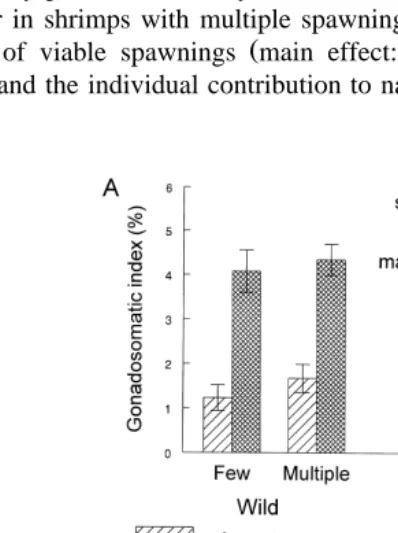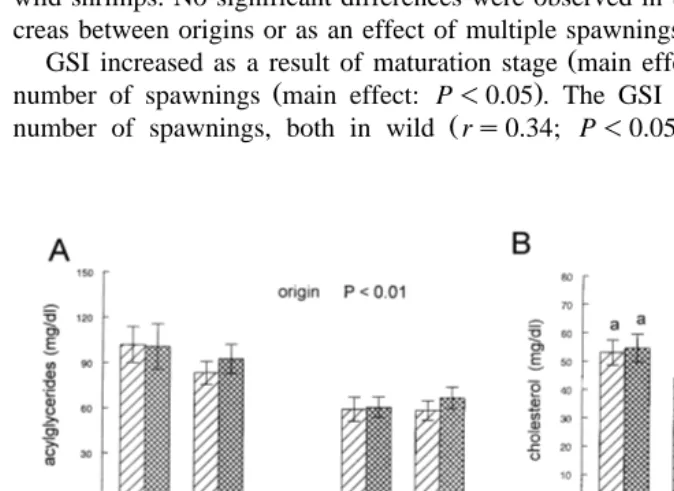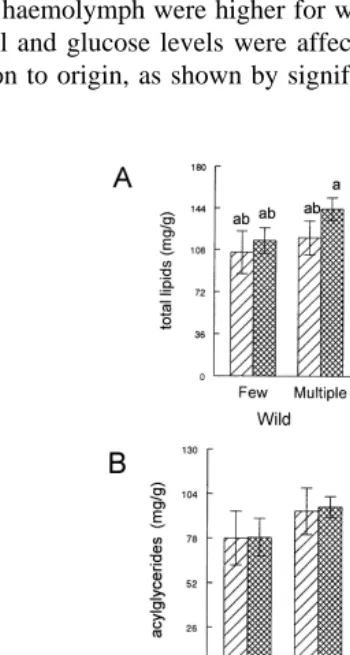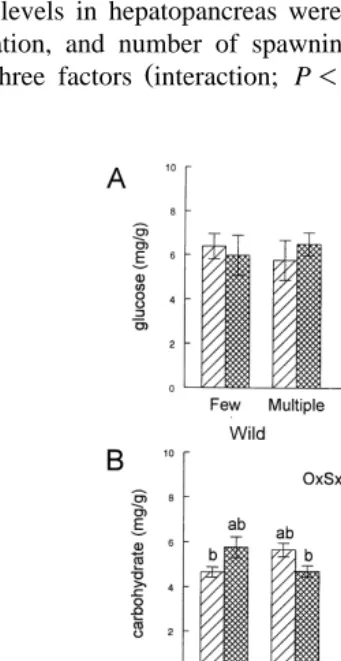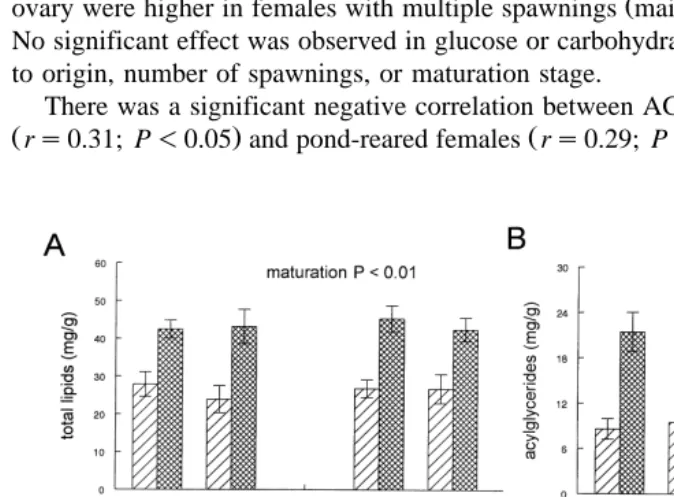Ž .
Aquaculture 185 2000 353–371
www.elsevier.nlrlocateraqua-online
Tissue biochemical composition in relation to
multiple spawning in wild and pond-reared
Penaeus
Õ
annamei broodstock
E. Palacios, A.M. Ibarra, I.S. Racotta
)DiÕision de Biologıa Marina, Centro de In´ ´ Õestigaciones Biologicas del Noroeste, Apdo. Postal 128, La Paz,´
Baja California Sur 23000, Mexico
Accepted 1 November 1999
Abstract
The effect of the number of spawnings on several biochemical components of ovary, hepatopancreas, and haemolymph was investigated. Shrimps of two origins were compared; wild-caught and pond-reared spawners. Individually tagged females were sampled at the end of a production period in a commercial hatchery. Females with multiple spawnings had a higher
Ž .
gonadosomatic index GSI , increased levels of protein in the ovary, and increased levels of
Ž .
acylglycerides AG and total protein in the hepatopancreas. Wild shrimps had a higher fecundity and higher levels of AG in hepatopancreas, and AG, cholesterol, protein, and glucose in haemolymph. Pond-reared shrimps had a higher hepatosomatic index than wild counterparts. The biochemical composition of the ovary reflected the typical nutrient accumulation associated with maturation. The capacity for multiple spawning could be related to metabolism of energetic lipids that are accumulated in the hepatopancreas, which in turn depends on size and origin of the broodstock. Females with multiple spawning capacity may be adequate for production purposes, although more research is needed to address the possibility of specific metabolic indicators of a multiple spawning capacity without a decline in spawn quality, and to define whether this is an
inherited characteristic that can be selected in an improvement program.q2000 Elsevier Science
B.V. All rights reserved.
Keywords: Shrimp reproduction; Multiple spawnings; Lipids; Hepatopancreas; Ovary; Haemolymph
)Corresponding author. Tel.:q52-112-5-36-33, ext. 144; fax:q52-112-5-47-15.
Ž .
E-mail address: [email protected] I.S. Racotta .
0044-8486r00r$ - see front matterq2000 Elsevier Science B.V. All rights reserved.
Ž .
( ) E. Palacios et al.rAquaculture 185 2000 353–371
354
1. Introduction
The majority of the nauplii production in a hatchery can be attributed only to a
Ž .
limited proportion of females McGovern, 1988; Bray et al., 1990; Cavalli et al., 1997 . The females that contribute to the majority of the production share at least one common
Ž
characteristic: an ability for frequent and multiple spawnings Bray et al., 1990; Wyban .
and Sweeney, 1991; Palacios et al., 1999b . Shrimps can remature and have successive spawnings in a relatively short time as a consequence of eyestalk ablation. However, frequent spawning and the implied shorter period for maturation have deleterious effects on the female. The effect of repeated spawnings was first described and named
Ž .
‘‘reproductive exhaustion’’ by Lumare 1979 , who observed that females of Penaeus
kerathurus with several spawnings had ovaries that did not fully enlarge and did not
have a uniform development. If a female has frequent periods of maturation, there may be insufficient time for the necessary accumulation of nutrients in the hepatopancreas
Ž
and their transport to the ovary Aquacop, 1977; Beard and Wickins, 1980; Emmerson, .
1980; Primavera, 1985; Harrison, 1990; Browdy, 1992 . The assessment of the produc-tive capacity of females that have had successive periods of rematuration and spawning
Ž
has produced contradictory results Beard and Wickins, 1980; Ottogalli et al., 1988; . Bray et al., 1990; Hansford and Marsden, 1995; Sagi et al., 1997; Palacios et al., 1999b . Adequate maturation conditions, that could counteract a rapid depletion of reserves of the female, could explain why successive spawnings are not necessarily associated with
Ž
an apparent decrease in the quality of the offspring Emmerson, 1980; Browdy et al., .
1986; Harrison, 1990; Marsden et al., 1997 . However, the effect of successive spawnings has yet to be addressed biochemically.
Increasing interest has been placed on the use of pond-reared shrimps as an alternative to wild shrimps in hatcheries. The use of pond-reared spawners has several advantages; their year-round availability, decreased seasonal variations, the capability of having genetic improvement programs, and the reduced impact on other fisheries. However, their use has been limited because it has long been believed that pond-reared shrimps do not have a satisfactory reproductive performance. In a previous paper, we found an overall acceptable reproductive performance of pond-reared shrimps compared
Ž .
to wild spawners in spite of differences in size Palacios et al., 1999b .
In the present study, the relations between several biochemical components and the number of spawnings were investigated in P.Õannamei. Wild and pond-reared spawners were compared to determine if the origin of the shrimps affects the reserves and maturation capabilities during successive spawnings in different ways.
2. Material and methods
2.1. General hatchery conditions
Wild and pond-reared adult shrimps were matured at the commercial hatchery
Ž .
Sinaloa-( )
E. Palacios et al.rAquaculture 185 2000 353–371 355
Ž . Ž .
Nayarit Mexico , and averaged 50 g. A first generation G1 of pond-reared broodstock
´
Ž .
was obtained from wild spawners G0 and were raised until they reached 20 g, for 4 months in tidal earthern ponds at a density of 5 shrimpsrm2 and with pellets, containing
Ž .
35% protein, of a commercial grow-out diet P.I.A.S.A, La Paz, B.C.S., Mexico . At 20
´
Ž .
g, shrimps were further grown to spawner size approximately 35 g for 5 months at CIBNOR, at a density of 1 shrimprm2. Fresh squid was offered twice a week
Žapproximately 10% of biomass on a fresh weight basis in addition to pellets. These.
Ž . Ž .
shrimps G1 were used as spawners by APSA, to obtain a second generation G2 of domesticated shrimps. Grow-out of G2 was done in conditions similar for G1 except when an average weight of 11.5 g was obtained, a selection for weight of 1000
Ž .
individuals from the top 20% was made )14 g . The selected shrimps were grown to
Ž .
the size of spawners 35 g, age 12 months under conditions similar for G1.
Shrimps were stocked and matured under the hatchery conditions: 25 m2 black
fiberglass maturation tanks, 6 animalsrm2, 1:1 male to female ratio, 200% daily water
Ž .
exchange, and 288C and 36 ppt average temperature and salinity . The diet was composed of 40% squid, 15% polychaetes, 40% clams, and 5% of a commercial
Ž .
maturation diet Rangen, ID, USA divided into five daily rations accounting for a total daily supply of 10% of biomass. After 1 week of acclimation period, during which 80% of the animals molted, females were subjected to unilateral eyestalk ablation by cutting, and individually tagged with a color- and number-coded ring placed around the remaining eyestalk. Gonad development was monitored daily, and mature females with an attached spermatophore were placed in individual 160 l spawning tanks. The number
Ž .
of eggs per female fecundity was recorded from three 5 ml subsamples after stirring the spawning tank. In the morning, after recording the code, the females were returned to the maturation tank. Fertilization rate per spawn was assessed in three 5 ml samples of each spawn, based upon the presence of a double membrane in the egg. Viable
Ž .
spawns fertilization rate)40% were transferred to 70 l fiberglass tanks for hatching. On the next day, nauplii were collected by positive phototropism: nauplii attracted by a light source were transferred to a bucket where they were counted in three samples of 5 ml each.
2.2. Sampling
In November 1996, at the end of the production cycle, tagged females were sampled. Total weight of the females was determined after blotting them dry. Total length and width of the first abdominal segment were also recorded. From the pleopod base of the first abdominal segment of each female, 300ml of haemolymph was obtained using a 1 ml syringe rinsed with precooled anticoagulant solution of 5% sodium oxalate in isotonic saline. The haemolymph was centrifuged in a Eppendorf centrifuge for 2 min, and the plasma separated from the precipitated cells and stored at y708C for further biochemical analysis. The gonad from the abdominal region was dissected and fixed in
Ž Davidson solution for 24 h, embedded in a paraffin–paraplast mixture, sectioned 6 to 8
. Ž .
( ) E. Palacios et al.rAquaculture 185 2000 353–371
356
Ž .
stored aty708C until further analysis. The gonadosomatic index GSI and hepatopan-Ž .
creatic index HPI were calculated as their proportion relative to total body weight by Ž .
subtracting the weight of the gonad, as proposed by Clarke 1982 . A sample of a uropod was taken from each female to assess the molting stage, and only those females
Ž . in moulting stage C and early D, as described by Robertson et al. 1987 , were
Ž .
considered for the analysis ns56 wild and ns44 pond-reared .
2.3. Biochemical analysis
Samples of tissue were weighed and homogenized in 3 ml of saline solution with Polytron. Part of the homogenate was centrifuged at 3000 rpm for 10 min. Enzymatic–
Ž . Ž . Ž
colorimetric analyses for glucose GOD-PAP, Merck , acylglycerides AG GPOPAP,
. Ž . Ž .
Merck , lactate Sigma , and cholesterol ChodPAP, Merck were made with an Ž
adaptation for small samples using ELISA-microplates on the plasma Palacios et al.,
. Ž .
1998 or the centrifuged homogenate. Protein Bradford, 1976 was determined in the Ž . plasma or in the crude homogenate after digestion with 0.1 N NaOH. Total lipids TL
Ž .
were determined by the sulphophosphovanillin method Barnes and Blackstock, 1973 ,
Ž .
and total carbohydrates with the anthrone method Van Handel, 1965 .
2.4. Statistical analysis
Two-way analysis of variance followed by a Tukey test for unequal N post-hoc mean
Ž .
comparisons Statistica Version 4.3 were made to assess significant differences in Ž morphometric and production variables, using as independent parameters origin O: wild
. Ž
and pond and number of viable spawns per female S: divided in three groups: from .
one to three, between four and eight, and more than nine spawns per female . Spawnings with a fertilization rate of -40% were considered as nonviable spawns.
Three-way analysis of variance followed by a Tukey test for unequal N post-hoc mean comparisons were done to assess significant differences in biochemical
composi-Ž . Ž
tion of tissues, using origin O: wild and pond-reared , number of spawns S: divided in
. Ž
two groups: one to four and five or more spawns per female , and maturation stage M: .
immature and ripe as independent variables. The stage of maturation was assigned according to the oocyte type and maximum oocyte diameter for each female, determined
Ž .
in a parallel work Palacios et al., 1999c . Females with previtellogenic and early vitellogenic oocytes, which corresponds to the previtellogenic stage described by
Ž .
Tan-Fermin and Pudadera 1989 , and maximum oocyte diameter smaller than 150mm
Ž .
were classified as immature 102"6 mm . Females classified as mature had a
maxi-Ž .
mum oocyte diameter larger than 150 mm 228"6 mm , and had late vitellogenic
Ž . Ž .
oocytes vitellogenic stage and oocytes with cortical rods cortical stage , as described Ž .
by Tan-Fermin 1989 .
Pearson’s correlations between the number of spawns per female and biochemical levels in tissue were made. The AGrTL expressed as percentage was transformed to
Ž .
()
Differences in production variables as an effect of spawning order in wild and pond-reared P.Õannamei broodstock mean"SE
Data were classified according to the number of viable spawnings of the females: less than three spawnings, between four and eight spawnings, and more than nine spawnings. The results of the ANOVA are presented in the last column: main effect of origin, number of spawnings, and interaction. N.S. means not significant.
Number of spawnings Less than Four to eight More than Origin,
three spawnings spawnings nine spawnings Spawnings
Interaction
Days to first spawning Wild 40.3"10.7 24.8"2.1 26.0"4.0 N.S.
Pond 33.6"4.7 22.0"3.0 17.0"6.4 P-0.05 N.S.
No. of spawningsrmonthrfemale Wild 1.13"0.23 2.56"0.27 3.60"0.46 N.S.
Pond 1.01"0.12 2.78"0.13 3.75"0.33 P-0.01 N.S. No. of viable spawningsrmonthrfemale Wild 0.55"0.12 1.94"0.17 3.21"0.58 N.S.
Pond 0.65"0.09 1.99"0.10 3.08"0.26 P-0.01 N.S.
% Viable spawnings Wild 59.8"13.6 77.1"4.0 84.9"9.2 N.S.
Pond 65.2"6.2 75.0"3.7 82.0"1.2 P-0.05 N.S. 3
Ž .
Number of eggsrspawnrfemale =10 Wild 194.1"12.2 197.7"18.7 215.3"16.9 P-0.05 Pond 110.0"11.6 149.4"08.7 189.6"13.0 P-0.05
N.S.
% Fertilization Wild 65.1"6.0 63.3"2.1 72.9"5.1 N.S.
Pond 58.0"3.4 63.0"2.6 68.0"3.3 N.S. N.S. 3
Ž .
Number of naupliirspawnrfemale =10 Wild 41.2"5.1 55.5"10.7 73.4"3.9 N.S. Pond 53.3"5.2 52.7"6.3 51.8"4.9 P-0.05
P-0.05 3
Ž .
Total nauplii produced by each female =10 Wild 140.4"20.9 487.3"30.0 830.1"110.9 P-0.05 Pond 160.5"17.7 427.0"21.2 675.9"56.3 P-0.01
()
E.
Palacios
et
al.
r
Aquaculture
185
2000
353
–
371
358
Table 2
Ž .
Differences in morphometric variables as an effect of spawning order in wild and pond-reared P.Õannamei broodstock means"SE
Females were classified according to the number of viable spawnings into three groups: less than three spawnings, between four and eight spawnings, and more than nine spawnings. The results of the ANOVA are presented in the last column: main effect of origin, number of spawnings, and interaction. N.S. means not significant.
Number of spawnings Less than Four to eight More than Origin,
three spawnings spawnings nine spawnings Spawnings
Interaction
Ž .
Body weight g Wild 50.0"2.5 52.9"1.7 51.8"2.9 P-0.01
Pond 37.0"0.8 41.2"1.0 46.1"3.0 P-0.05 N.S.
Ž .
Body length cm Wild 17.5"0.3 17.8"0.2 17.6"0.3 P-0.01
Pond 15.9"0.2 16.5"0.1 17.3"0.8 P-0.05 N.S.
Ž .
Width first abdominal segment cm Wild 1.80"0.05 1.87"0.03 1.81"0.05 P-0.05 Pond 1.65"0.02 1.74"0.02 1.84"0.08 P-0.01
N.S.
Ž .
Ovary weight g Wild 1.03"0.20 1.48"0.15 1.80"0.33 P-0.05
Pond 0.65"0.07 1.12"0.13 1.41"0.48 P-0.01 N.S.
Ž .
HP weight g Wild 0.90"0.08 0.98"0.06 1.13"0.05 N.S.
( )
E. Palacios et al.rAquaculture 185 2000 353–371 359
presented. Data are reported as mean"standard error. The level of significance was preset at P-0.05.
3. Results
3.1. ProductionÕariables
The latency period between eyestalk ablation and the first spawning for each female
Ž .
was shorter in shrimps with multiple spawnings main effect: P-0.05; Table 1 . The
Ž . Ž
proportion of viable spawnings main effect: P-0.05 , the fecundity main effect:
. Ž .
P-0.05 , and the individual contribution to nauplii production main effect: P-0.05
Ž . Ž .
Fig. 1. Means"SE of gonadosomatic A and hepatosomatic indices B in wild and pond-reared P.Õannamei
broodstock in relation to the number of spawnings and maturation stage. The results of the trifactorial analysis
Ž .
of variance are inserted in the figure. Factors considered for the analysis were origin wild vs. pond-reared ,
Ž .
maturation stage immature vs. ripe, grouped according to the maximum oocyte diameter , and number or
Ž .
spawnings fewsless than 4 vs. multiplesmore than 4 . The main effects and interactions are shown only when significant. A mean comparison was done by Tukey test for unequal n only when there was a significant
Ž .
( ) E. Palacios et al.rAquaculture 185 2000 353–371
360
Ž .
was higher in shrimps with multiple spawnings Table 1 . Wild females had a higher
Ž .
fecundity than pond-reared shrimps main effect: P-0.05; Table 1 . Wild females with Ž multiple spawnings produced more naupliirspawn than pond-reared shrimps
interac-. Ž .
tion: P-0.05 or wild shrimps with few spawnings main effect: P-0.05; Table 1 . No other significant differences were found in the production variables between origins.
3.2. MorphometricÕariables
Ž . Ž .
Body weight main effect: P-0.05 and ovary weight main effect: P-0.01 were
Ž .
higher in females with multiple spawnings Table 2 . Wild females had higher body
Ž . Ž .
weight main effect: P-0.05 and ovary weight main effect: P-0.05 than
pond-re-Ž .
ared shrimps Table 2 . Body weight was positively correlated with multiple spawnings
Ž .
in pond-reared shrimps rs0.47; P-0.01 , but no significant correlation was found in wild shrimps. No significant differences were observed in the weight of the hepatopan-creas between origins or as an effect of multiple spawnings.
Ž .
GSI increased as a result of maturation stage main effect: P-0.01; Fig. 1A , and
Ž .
number of spawnings main effect: P-0.05 . The GSI was positively correlated to
Ž .
number of spawnings, both in wild rs0.34; P-0.05 , and pond-reared females
Ž . Ž . Ž .
Fig. 2. Means"SE of haemolymph concentration of AG A , cholesterol B , glucose C , and total protein
Ž .D in wild and pond-reared P.Õannamei broodstock in relation to the number of spawnings and maturation
( )
E. Palacios et al.rAquaculture 185 2000 353–371 361
Žrs0.33; P-0.01 . The hepatosomatic index HPI was higher in pond-reared females. Ž .
Ž .
than wild shrimps main effect: P-0.01; Fig. 1B . No significant differences in HPI were observed as a result of maturation stage or number of spawnings, and no correlation between the number of spawnings and the HPI was found.
3.3. BiochemicalÕariables in haemolymph
Ž . Ž .
AG main effect: P-0.01; Fig. 2A , cholesterol main effect: P-0.01; Fig. 2B ,
Ž . Ž
glucose main effect: P-0.05; Fig. 2C , and total protein main effect: P-0.05; Fig. .
2D levels in haemolymph were higher for wild females than for pond-reared spawners. Cholesterol and glucose levels were affected by number of spawnings in a different way in relation to origin, as shown by significant interactions depicted in Fig. 2B,C.
Ž . Ž . Ž .
Fig. 3. Means"SE of hepatopancreas concentration of TL A , AG B , and AGrTL ratio C in wild and pond-reared P.Õannamei broodstock in relation to the number of spawnings and maturation stage. See Fig. 1
( ) E. Palacios et al.rAquaculture 185 2000 353–371
362
3.4. BiochemicalÕariables in hepatopancreas
Ž
AG levels in hepatopancreas were higher in wild spawners main effect: P-0.05; .
Fig. 3B . Regardless of origin and maturation, shrimps with multiple spawnings had
Ž . Ž
higher levels of AG main effect: P-0.05 , AGrTL ratio main effect: P-0.01; Fig.
. Ž .
3C , and total protein main effect: P-0.01; Fig. 4C levels in hepatopancreas.
Ž .
AGrTL ratio was lower in mature females main effect: P-0.05; Fig. 3C . TL levels in hepatopancreas were affected in a different way in relation to origin and number of
Ž .
spawnings, as shown by a significant interaction interaction; P-0.05; Fig. 3A . Carbohydrate levels in hepatopancreas were affected in a different way in relation to origin, maturation, and number of spawnings, as shown by a significant interaction
Ž .
between the three factors interaction; P-0.05; Fig. 4B . No significant effect was
Ž . Ž . Ž .
Fig. 4. Means"SE of hepatopancreas concentration of glucose A , carbohydrate B , and total protein C in wild and pond-reared P.Õannamei broodstock in relation to the number of spawnings and maturation stage.
( )
E. Palacios et al.rAquaculture 185 2000 353–371 363
observed in the glucose levels in hepatopancreas in relation to origin, number of spawnings, or maturation stage.
A positive correlation between number of spawnings and AG levels was found for
Ž . Ž .
wild rs0.41; P-0.01 and pond-reared females rs0.25; P-0.05 . A positive correlation was found between number of spawnings and AGrTL ratio for wild Žrs0.52; P-0.01 and pond-reared females r. Ž s0.37; P-0.05 . A positive correla-. tion between number of spawnings and carbohydrate levels was found for wild Žrs0.30; P-0.05 and pond-reared females r. Ž s0.39; P-0.01 ..
3.5. BiochemicalÕariables in oÕary
Ž . Ž
Regardless of origin, higher levels of TL main effect: P-0.01; Fig. 5A , AG main
. Ž .
effect: P-0.01; Fig. 5B , cholesterol main effect: P-0.01; Fig. 5D , and total protein Žmain effect: P-0.01; Fig. 6C were found in females with ripe ovaries. AG. rTL ratio
Ž .
in ripe females was affected by origin interaction: P-0.05; Fig. 5C . Protein levels in
Ž .
ovary were higher in females with multiple spawnings main effect: P-0.05; Fig. 6C . No significant effect was observed in glucose or carbohydrate levels in ovary in relation to origin, number of spawnings, or maturation stage.
There was a significant negative correlation between AGrTL ratio and GSI for wild Žrs0.31; P-0.05 and pond-reared females r. Ž s0.29; P-0.05 , between lipid levels.
Ž . Ž . Ž . Ž .
Fig. 5. Means"SE of ovary concentration of TL A , AG B , AGrTL ratio C , and cholesterol D in wild and pond-reared P.Õannamei broodstock in relation to the number of spawnings and maturation stage. See
( ) E. Palacios et al.rAquaculture 185 2000 353–371
364
Ž . Ž . Ž .
Fig. 6. Means"SE of ovary concentration of glucose A , carbohydrate B , and total protein C in wild and pond-reared P.Õannamei broodstock in relation to the number of spawnings and maturation stage. See Fig. 1
for statistical analysis.
Ž . Ž
in the ovary and GSI for wild rs0.53; P-0.01 and pond-reared shrimps rs0.69;
. Ž .
P-0.01 , and between AG levels in ovary and GSI for wild rs0.41; P-0.01 and
Ž .
pond-reared shrimps rs0.38; P-0.01 . A positive correlation between total protein
Ž .
levels in ovary and number of spawnings was found for wild rs0.27; P-0.05 and
Ž .
pond-reared females rs0.32; P-0.05 .
4. Discussion
( )
E. Palacios et al.rAquaculture 185 2000 353–371 365
Ž
lipids, in the maturing ovary has been reported in several shrimp species Gehring, 1974; Kulkarni and Nagabhushanam, 1979; Galois, 1984; Castille and Lawrence, 1989; Millamena and Pascual, 1990; Mourente and Rodrıguez, 1991; Mohamed and Diwan,
´
.
1992 . In the present study, an increase in the level of TL, AG, cholesterol, and total proteins in mature ovaries was observed. The positive correlation between lipid levels in
Ž .
the ovary and GSI is in agreement with Galois 1984 , who found a correlation between lipid accumulation in the ovary and the GSI. AG represents the bulk of lipids in the hepatopancreas, whereas in the ovary, this lipid class represents a lower fraction because
Ž
phospholipids are reported to be predominant Gehring, 1974; Chapelle, 1986; Milla-.
mena and Pascual, 1990; Mourente and Rodrıguez, 1991 . Several authors have reported
´
a decrease in total or specific lipids in the hepatopancreas during maturation, and assume Ž
they are transfered to the ovary Galois, 1984; Teshima et al., 1988; Castille and .
Lawrence, 1989; Millamena and Pascual, 1990 . Depletion of TL in hepatopancreas
Ž .
could also be explained by a decrease in dietary lipid Clarke, 1982 or by an increase in
Ž .
energy consumption Teshima et al., 1988; Harrison, 1990 . However, as in the present work, this decrease has not always been observed, and several factors such as species differences, use of eyestalk ablation, and influence of diet could partially explain these
Ž
conflicting results Castille and Lawrence, 1989; Mourente and Rodrıguez, 1991;
´
.
Millamena et al., 1993 . A decrease in the hepatopancreas of the relative amount of AG ŽAGrTL ratio in ripe females was observed in the present study, which could indicate a. transfer of this particular lipid class to the ovaries. The biochemical levels in hepatopan-creas and haemolymph were affected by the maturation stage in a different way in wild and pond-reared shrimps, but these differences were also a consequence of the number of spawnings and will be discussed below.
The goal of hatcheries is to increase production. This increased production is forced by the eyestalk ablation of females. However, continuous forced reproduction has been suggested to produce exhaustion of the female reserves because of insufficient time
Ž
between spawnings to allow the shrimps to accumulate sufficient nutrients Aquacop, . 1977; Beard and Wickins, 1980; Primavera, 1985; Harrison, 1990; Browdy, 1992 . If this is true, females with multiple spawnings would be expected to have diminished reserves, especially in the ovary, and as a consequence, to have an inadequate matura-tion process. If a female with diminished reserves is forced to mature, it may produce eggs of lower quality. It has been reported the first spawnings of a female are the best in
Ž
terms of fecundity, fertilization, hatching, and metamorphosis rates Beard and Wickins, . 1980; Emmerson, 1980; Bray et al., 1990; Marsden et al., 1997; Palacios et al., 1998 . However, in a number of cases, no substantial alterations in spawn quality with
Ž
successive spawnings have been reported Browdy and Samocha, 1985; Ottogalli et al., .
1988; Palacios et al., 1999b .
Comparison of the biochemical levels between females with few or multiple spawn-ings revealed higher levels of AG, total proteins and carbohydrates, and AGrTL ratio in the hepatopancreas and increased levels of protein in the ovary of females with multiple spawnings. However, no differences were observed in the AG fraction or TL in the
Ž .
ovary. In agreement, Vazquez-Boucard 1990 found no differences in TL and lipovitellin
´
( ) E. Palacios et al.rAquaculture 185 2000 353–371
366
kind of regulation of the reserves. The ovary may need to reach a certain level of reserves to mature and spawn. If these levels are not reached, instead of spawning, the ovary may enter a reabsorption phase. Females that had a low spawning frequency did have a high incidence of oocyte atresia and reabsorption before maturation was fully
Ž .
completed and the female had a chance to spawn Palacios et al., 1999c . Eyestalk ablation could be forcing females in a poor physiological condition, or that are channeling energy into growth, to enter the process of maturation and later reabsorb the gonad without spawning. An analogous physiological situation is the well-known reabsorption of mature ovaries at the premoult stage, and it was concluded that this may
Ž help in the conservation of energy and in synchronizing molt and reproduction
Emmer-.
son, 1980; Adiyodi, 1985; Browdy, 1992; Quinitio et al., 1993 . If a female is in a poor condition and has few reserves, it may fail to spawn or it may produce poor quality spawnings. However, if it is in excellent condition, it can be expected to have multiple and therefore, more frequent spawnings through the production period.
The reason why AG content and its relative proportion to TL levels in hepatopancreas are higher in females with multiple spawnings is not known. This result is surprising and appears to be contrary to the hypothesis of depletion of reserves associated with
Ž .
successive rematurations Primavera, 1985; Harrison, 1990 , and with the decrease in total and specific lipid classes in hepatopancreas in mature P. indicus females that had
Ž
spawned three times compared to females that only spawned once Vazquez-Boucard,
´
.
1990 . Increased levels in some reserves of the hepatopancreas could be a result of diminished transfer from the hepatopancreas to the ovary. However, the differences found in the hepatopancreas of females with multiple spawnings did not seem to affect the biochemical reserves in ovaries. Therefore, it is assumed that the transfer from the hepatopancreas to the ovary is not reduced in such a way as to alter the levels of reserves in the ovary.
In addition to the data presented above, four immature females that never spawned were sampled. When the biochemical data of these females were compared with the
Ž .
other immature females of both groups few and multiple spawnings , females with no Ž
spawning had significantly lower levels of AG in the hepatopancreas no spawnings41.9 . mgrg; few spawningss77.9 mgrg; multiple spawningss94.1 mgrg; P-0.05 , and
Ž
of protein in the hepatopancreas no spawnings14.5 mgrg; few spawningss15.6 .
mgrg; multiple spawningss20.6 mgrg; P-0.01 . Therefore, the influence of succes-sive periods of maturation could be addressed in another way; females that accumulate more AG and protein in the hepatopancreas may have the capacity to remature several times. It is possible that an efficient assimilation, storage, and mobilization of nutrients Žparticularly the energetic lipid fraction, i.e., AG are reflected in their content in the. hepatopancreas. In turn, the ability of individuals to have successive periods of maturation and spawning could be related to an increased metabolic efficiency in the process considered above, which is associated with higher levels of neutral lipids in the hepatopancreas. If this is so, more research is needed to address the possibility of specific metabolic indicators of a multiple spawning capacity without a decline in spawn quality and to define whether this is an inherited characteristic that can be selected in a genetic improvement program. For example, the four females that had not spawned had
Ž
( )
E. Palacios et al.rAquaculture 185 2000 353–371 367
.
few spawningss140.9 mgrdl; multiple spawningss144.2 mgrdl; P-0.05 . This is Ž .
in agreement with Aquacop 1983 , who had suggested that protein levels in haemolymph could be used as a predictive indicator of the spawning capabilities. This could have important implications for production purposes because it is not known why pronounced differences in maturation capabilities between females exist even when the overall conditions are the same for all individuals. The biochemical analyses were done at the end of 3 months production period, and it seems likely that the biochemical variables
Ž .
were affected by the maturation conditions e.g., diet . Further studies are needed to explore predictive metabolic indicators of multiple spawning capability, evaluated before the females are used in production.
If there are no differences in the accumulation of reserves in the ovary as a result of multiple spawnings, we would expect the larvae of a first or last spawning to be of similar quality. We did not observe an effect of the number of spawnings on fertilization ŽTable 1 , and percent of viable spawnings was higher in females with multiple.
Ž .
spawnings Table 1 . In agreement, an individual follow-up of tagged females in the same maturation condition has shown there is no substantial decline of the spawn quality as an effect of the number of spawnings evaluated from fertilization and hatching rates ŽPalacios et al., 1999b , or in the maturation process of the oocytes in relation to number.
Ž .
of spawnings Palacios et al., 1999c . However, we have also found that the spawn
Ž .
quality decreases over the time spent in a production cycle Palacios et al., 1998, 1999a . The females used in the present study were sampled at the end of the production cycle, and we can only speculate on the biochemical reserves the females had at the beginning of the cycle. It is possible that spawners at the beginning of the cycle have more reserves or have a better overall condition compared to females that have been in production for several months. As a consequence, the decrease in the quality of the spawn that can be observed over the production period would be a consequence of a decrease in reserves of the females over the production cycle. However, this decrease is not necessarily a direct consequence of the number of spawnings, but it is possible that it is a result of
Ž
other maturation conditions that can be altered during the production cycle i.e., diet, .
disease, stress, ablation . Further studies are needed to elucidate possible differential effects of time after eyestalk ablation and number of spawnings on adult and larval characteristics.
We did not find significant differences in the biochemical levels in the ovary between wild and pond-reared shrimps. This is in agreement with previous results in which no differences in the biochemical composition of the resulting eggs and nauplii were
Ž .
obtained between wild and pond-reared spawners Ibarra et al., 1997 . In addition, the proportions of vitellogenic and cortical oocytes or oocyte diameter in each maturation
Ž .
stage were also similar for both origins Palacios et al., 1999c . However, fecundity was higher in wild spawners compared to pond-reared shrimps. The number of eggs is
Ž
known to be related to spawner size Aquacop, 1977; Emmerson, 1980; Ottogalli et al., .
1988; Hansford and Marsden, 1995; Cavalli et al., 1997; Ibarra et al., 1997 , and this could explain the higher fecundity of wild shrimps. A positive correlation was found
Ž .
( ) E. Palacios et al.rAquaculture 185 2000 353–371
368
Ž .
related to the spawning frequency Palacios et al., 1999b , and the fecundity would represent the maximum number of eggs that a shrimp of that size may produce. Pond-reared females were ablated at a smaller size than wild counterparts, and as a consequence, they may be channeling their nutrients into somatic growth rather than
Ž .
reproduction Quinitio et al., 1993 . In accordance, body weight of pond-reared females that had not spawned was lower than that of pond-reared females with multiple
Ž
spawnings, with intermediate values for females with few spawnings no spawnings .
34.6 g; few spawningss37.2 g; multiple spawningss42.4 g; P-0.05 . If small shrimps have to channel their energy to both growth and reproduction, pond-reared shrimps probably have to deplete their hepatopancreatic reserves or increase the hepatopancreatic metabolism. In the present study, wild shrimps had higher levels of AG in hepatopancreas and higher levels of AG, cholesterol, glucose, and protein in haemolymph than pond-reared females. In contrast, previous work reported increased levels of neutral lipids in the hepatopancreas of farmed shrimps compared to those
Ž .
obtained from the wild O’Leary and Matthews, 1990; Jimenez et al., 1995 . These
´
Ž
differences could be attributed to dietary deficiencies of farmed shrimps O’Leary and .
Matthews, 1990; Jimenez et al., 1995 or to general rearing conditions which may play
´
Ž .
an important role in subsequent reproductive performance Browdy, 1992 . Prematura-tion condiPrematura-tions probably have little influence in the present study in which all animals were on the same diet for at least 3 months. Different capacities of assimilation, storage,
Ž .
and mobilization of several nutrients especially lipids could exist and explain our results when comparing wild and pond-reared shrimps. As discussed above, AG levels in hepatopancreas could be related to multiple spawning capacity in wild and pond-re-ared shrimps. This assumption could also explain differences between origins because
Ž .
wild organisms had higher AG in hepatopancreas present work and also had more
Ž .
spawnings Palacios et al., 1999b . Whether this finding can be related to the higher levels of several biochemical components in the hepatopancreas and haemolymph of wild shrimps, or to differences in size between wild and pond-reared females remains to be explained.
In conclusion, females with multiple spawning capacity are recommended for produc-tion purposes, although more studies are needed to address the resulting spawn and larval quality. This capacity could be related to metabolism of energetic lipids, which in turn depends on the size and origin of spawners. Ovary biochemical composition only reflects the typical nutrient accumulation associated with maturation but no relation was found with multiple spawning capacities, size, or origin of shrimps.
Acknowledgements
We acknowledge the collaboration of Acuacultores de la Paz for their donation of complete spawnings and their support during sample collection. We are also grateful to C. Rodrıguez-Jaramillo, S. Avila, S. Montes, P. Cruz, J.L. Ramırez, C. Ruiz-Verdugo
´
´
for their help during sample collection; to D. Carreno and R. Hernandez-Herrera for
˜
´
( )
E. Palacios et al.rAquaculture 185 2000 353–371 369
Tecnologıa. This research was supported by International Foundation for science grant
´
number Ar2711-1, Consejo Nacional de Ciencia y Tecnologıa grant number J28160B,
´
and institutional project CIBNOR-CM15.
References
Adiyodi, R.G., 1985. Reproduction and its control. In: The Biology of Crustacea. Bliss, D.E., Mantel, L.H.
ŽEds. , Integument, Pigments and Hormonal Processes Vol. 9 Academic Press, New York, pp. 147–215..
Aquacop, 1977. Reproduction in captivity and growth of Penaeus monodon, Fabricius in Polynesia. Proc. World Maricult. Soc. 8, 927–945.
Aquacop, 1983. Use of serum protein concentration to optimize penaeid shrimp quality. In: Rogers, G.L., Day,
Ž .
R., Lim, A. Eds. , Proceedings of the First International Conference Warmwater Aquaculture of Crustacea, 9–11 February. Brigham Young University, Laie, HI, pp. 373–381.
Barnes, H., Blackstock, J., 1973. Estimation of lipids in marine animals and tissues: detailed investigation of the sulphophosphovanillin method for ‘total’ lipids. J. Exp. Mar. Biol. Ecol. 12, 103–118.
Beard, T.W., Wickins, J.F., 1980. Breeding of Penaeus monodon Fabricius in laboratory recirculation systems. Aquaculture 20, 79–89.
Bradford, M.M., 1976. A rapid and sensitive method for the quantitation of microgram quantities of protein utilizing the principle of protein-dye binding. Anal. Biochem. 72, 248–253.
Bray, W.A., Lawrence, A.L., Lester, L.J., 1990. Reproduction of eyestalk-ablated Penaeus stylirostris fed various levels of total dietary lipids. J. World Aquacult. Soc. 21, 41–52.
Browdy, C., 1992. A review of the reproductive biology of Penaeus species: perspectives on controlled
Ž .
shrimp maturation systems for high quality nauplii production. In: Wyban, J. Ed. , Proceedings of the Special Session on Shrimp Farming. World Aquaculture Society, Baton Rouge, LA, USA, pp. 22–51. Browdy, C.L., Hadani, A., Samocha, T.M., Loya, Y., 1986. The reproductive performance of wild and
pond-reared Penaeus semisulcatus de Haan. Aquaculture 59, 251–258.
Browdy, C.L., Samocha, T.M., 1985. The effect of eyestalk ablation on spawning, molting and mating of
Penaeus semisulcatus de Haan. Aquaculture 49, 19–29.
Castille, F.L., Lawrence, L.A., 1989. Relationship between maturation and biochemical composition of the
Ž .
gonads and digestive glands of the shrimps Penaeus aztecus Ives and P. setiferus L. . J. Crustacean Biol. 9, 202–211.
Cavalli, R.O., Scardua, M.P., Wasielesky, W. Jr., 1997. Reproductive performance of different sized wild and pond-reared Penaeus paulensis females. J. World Aquacult. Soc. 28, 260–267.
Chapelle, S., 1986. Aspects of phospholipid metabolism in crustaceans as related to changes in environmental temperatures and salinities. Comp. Biochem. Physiol. B 84, 423–439.
Clarke, A., 1982. Lipid synthesis and reproduction in the polar shrimp Chorismus antarticus. Mar. Ecol.: Prog. Ser. 9, 81–90.
Emmerson, W.D., 1980. Induced maturation of prawn Penaeus indicus. Mar. Ecol.: Prog. Ser. 2, 121–131. Galois, R.G., 1984. Variations de la composition lipidique tissulaire au cours de la vitellogenese chez la`
crevette Penaeus indicus Milne Edwards. J. Exp. Mar. Biol. Ecol. 84, 155–156.
Gehring, W.R., 1974. Maturational changes in the ovarian lipid spectrum of the pink shrimp, Penaeus
duorarum duorarum Burkenroad. Comp. Biochem. Physiol. A 49, 511–524.
Hansford, S.W., Marsden, G.E., 1995. Temporal variation in egg and larval productivity of eyestalk ablated spawners of the prawn Penaeus monodon from Cook Bay, Australia. J. World Aquacult. Soc. 26, 396–405.
Harrison, K.E., 1990. The role of nutrition in maturation, reproduction and embryonic development of decapod crustaceans: a review. J. Shellfish Res. 9, 1–28.
Humanson, G.L., 1972. Animal Tissue Techniques. Freeman, San Francisco, CA, 641 pp.
Ibarra, A., Ramırez, J.L., Racotta, I.S., Palacios, E., Magallon, F., 1997. Performance comparison of eggs and´ nauplii for spawners from a second generation domesticated and wild shrimp of PenaeusÕannamei. In:
Ž .
( ) E. Palacios et al.rAquaculture 185 2000 353–371
370
Jimenez, M.A., Garcıa, E., Gandonou, G., Oliva, M., 1995. Metabolismo lipidico del hepatopancreas de´ ´
Penaeus schmitti en cultivo y del medio natural. Rev. Invest. Mar. 16, 157–164.
Kulkarni, K.G., Nagabhushanam, R., 1979. Mobilization of organic reserves during ovarian development in a
Ž . Ž .
marine penaeid prawn, Parapenaeopis hardwickii Miers crustacea, decapoda, penaeidae . Aquaculture 18, 373–377.
Lumare, F., 1979. Reproduction of Penaeus kerathurus using eyestalk ablation. Aquaculture 18, 203–214. Marsden, G.E., McGuren, J.J., Hansford, S.W., Burke, M.J., 1997. A moist artificial diet for prawn
broodstock: its effect on the variable reproductive performance of wild-caught Penaeus monodon. Aquaculture 149, 145–156.
McGovern, K.M., 1988. Management strategies for PenaeusÕannamei broodstock. J. World Aquacult. Soc.
19, 51A.
Millamena, O.M., Pascual, F.P., 1990. Tissue lipid content and fatty acid composition of Penaeus monodon Fabricius broodstock from the wild. J. World Aquacult. Soc. 21, 116–121.
Millamena, O.M., Pascual, R.A., Catacuta, F.P., 1993. Tissue lipid content and fatty acid composition during ovarian maturation of ablated Penaeus monodon. Isr. J. Aquacult. Bamidgeh 45, 120–125.
Mohamed, K.S., Diwan, A.D., 1992. Biochemical changes in different tissues during yolk synthesis in marine prawn Penaeus indicus H. Milne Edwards. Indian J. Mar. Sci. 21, 30–34.
Mourente, G., Rodrıguez, A., 1991. Variation in the lipid content of wild-caught females of the marine shrimp´
Penaeus kerathurus during sexual maturation. Mar. Biol. 110, 21–28.
O’Leary, C.D., Matthews, A.D., 1990. Lipid class distribution and fatty acid composition of wild and farmed
Ž .
prawn, Penaeus monodon Fabricius . Aquaculture 89, 65–81.
Ottogalli, L., Galinie, C., Goxe, D., 1988. Reproduction in captivity of Penaeus stylirostris in New Caledonia. J. Aqua. Trop. 3, 111–125.
Palacios, E., Ibarra, A.M., Ramırez, J.L., Portillo, G., Racotta, I.S., 1998. Biochemical composition of egg and´
Ž .
nauplii in White Pacific shrimp PenaeusÕannamei Boone , in relation to the physiological condition of
spawners in a commercial hatchery. Aquacult. Res. 29, 183–189.
Palacios, E., Perez-Rostro, C.I., Ramırez, J.L., Ibarra, A.M., Racotta, I.S., 1999a. Reproductive exhaustion in´
Ž .
shrimp PenaeusÕannamei reflected in larval biochemical composition, survival, and growth.
Aquacul-ture 171, 309–321.
Palacios, E., Racotta, I.S., APSA, 1999b. Spawning frequency analysis of wild and pond-reared of White Pacific shrimp PenaeusÕannamei broodstock under large-scale hatchery conditions. J. World Aquacult.
Soc. 30, 180–191.
Palacios, E., Rodrıguez-Jaramillo, C., Racotta, I.S., 1999c. Comparison of ovary histology between different-´
Ž .
size wild and pond-reared shrimp LitopenaeusÕannamei sPenaeusÕannamei . Invertebr. Reprod. Dev.
35, 251–259.
Primavera, J.H., 1985. A review of maturation and reproduction in closed thelycum penaeids. In: Taki, Y.,
Ž .
Primavera, J.H., Llobrera, J.A. Eds. , Proceedings of the First International Conference on the Culture of Penaeid PrawnsrShrimps, 4–7 December, Iloilo City, Philippines. pp. 47–64.
Quinitio, E., Caballero, R.M., Gustilo, L., 1993. Ovarian development in relation to changes in the external genitalia in captive P. monodon. Aquaculture 114, 71–81.
Robertson, L., Bray, W., Leung-Trujillo, J., Lawrence, A., 1987. Practical molt staging of Penaeus setiferus and Penaeus stylirostris. J. World Aquacult. Soc. 18, 180–185.
Sagi, A., Shoukrun, R., Levy, T., Barki, A., Hulata, G., Karplus, H., 1997. Reproduction and molt in previously spawned and first-time spawning red-claw crayfish Cherax quadricarinatus females following eyestalk ablation during the winter period. Aquaculture 156, 101–111.
Sokal, R.R., Rohlf, F.J., 1981. Biometry: The Principles and Practice of Statistics in Biological Research. Freeman, NY, 859 pp.
Tan-Fermin, J.D., Pudadera, R.A., 1989. Ovarian maturation stages of the wild giant tiger prawn, Penaeus
monodon Fabricius. Aquaculture 77, 229–242.
Teshima, S., Kanazawa, A., Koshio, S., Horinouchi, K., 1988. Lipid metabolism in destalked prawn Penaeus
japonicus: induced maturation and accumulation of lipids in the ovaries. Nippon Suisan Gakkaishi 54,
1115–1122.
( )
E. Palacios et al.rAquaculture 185 2000 353–371 371 Vazquez-Boucard, C., 1990. Etude de la Reproduction Chez les Crevettes Peneides; Nature et Devenir de la´ Masse Vitelline: Aspects Fondamentaux et Appliques. Centre d’Oceanologie de Marseille, France. These´ ´ ` de Doctorat, 171 pp.
